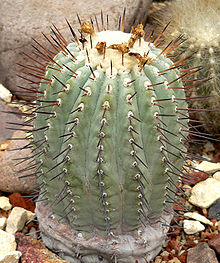- Copiapoa cinerea
-
Copiapoa cinerea 
Copiapoa cinerea Scientific classification Kingdom: Plantae (unranked): Angiosperms (unranked): Eudicots (unranked): Core eudicots Order: Caryophyllales Family: Cactaceae Subfamily: Cactoideae Tribe: Notocacteae Genus: Copiapoa Species: C. cinerea Binomial name Copiapoa cinerea
(Britton & Rose, 1922Copiapoa cinerea is a species of the genus Copiapoa in the family of Cactaceae. The name cinerea comes from the Latin word for ash, by reference to the colour of the epiderm.
It comes from the region of Antofagasta and the coastal zones of northern Chile. The area is very arid. However, there are dense fogs, due to cold streams of the Pacific ocean. These fogs are frequent, in early morning or late afternoon at an altitude between 500 and 850 m
This species is attractive because of the ash-grey to white coloured epidermis with typically black spines and wooly crown when adult. There is a contrast with the black spines.
Contents
Description
This cactus is globular, then columnar up to 1m, 20 cm diameter, 30 ribs. Only old plants offset from the base.
The light coloration is a protection against desiccation. In culture, the epidermis is often greenish.
Flowers are yellow, 2,5 cm diameter, at the top of the plants. Rare in cultivation
Cultivation
C. cinerea is slow growing and hard to keep, because of risk of rotting. Grafting is a solution. Before all, it needs well drained soils. Sunny place, but protection against excessive sun in summer. In summer, it needs light and regular watering, but let the soil dry between two waterings. In winter, keep warm (no less than 8°C) and absolutely dry.
Synonyms
- Echinocactus cinereus
Notes
Sources
- Anderson, Edward F. (2001) The Cactus Family Timber Press, Portland, Oregon, ISBN 0-88192-498-9
External links
- (English) photos on www.cactiguide.com
- (English) http://www.cactus-art.biz/schede/COPIAPOA/Copiapoa_cinerea/Copiapoa_cinerea/Copiapoa_cinerea.htm

This Cactaceae article is a stub. You can help Wikipedia by expanding it.
